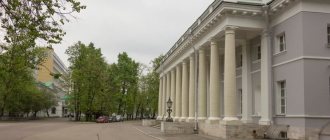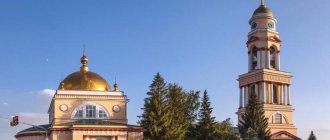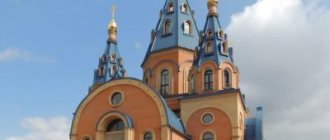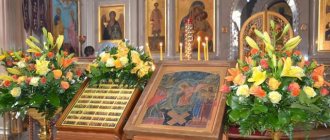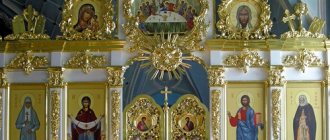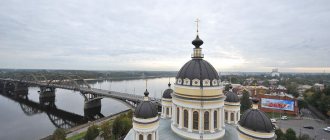The snow-white, five-domed Conception Church in the city of Chekhov appeared in 1694; at that time, instead of the city, there was the village of Zachatyevskoye, named after the church of the same name. The new temple was also consecrated in honor of the feast of the Conception of the Blessed Virgin Mary by Righteous Anna.
There is a very interesting legend about the birth of this handsome temple on the river bank. According to him, the Conception Church appeared for a reason. These lands then belonged to Savva Vasilchikov; the Vasilchikov couple remained childless for a long time, and this greatly upset them. Anna prayed a lot at the icon of the Conception of the Righteous Anna of the Most Holy Theotokos, and one day she heard in a dream a command from this icon to build a new church on the estate.
Soon the construction of the Conception Church began, and, according to legend, Anna became pregnant immediately after laying the first stone in the foundation of the church. After the allotted time, Vasilchikova gave birth to the daughter promised by God, whom she named Maria. This is the legend.
120 years later, the descendants of Savva Vasilchikov added a refectory with two chapels to the old church and the temple acquired modern forms. The chapels were consecrated in the name of St. Nicholas and in honor of the conception of John the Baptist.
A few more years later, a very beautiful three-tier bell tower in the Empire style appeared, which was crowned by a small but elegant rotunda of twelve columns, topped with a dome and spire. This is how the Conception Church was built by several generations of Vasilchikovs.
XX century
The Conception Church more or less successfully survived the years of the revolution. The authorities closed the temple only in 1962, turning it into a warehouse, and returned it to the community a quarter of a century later - in the year of the Millennium of the Baptism of Rus' - in 1988. These 25 years were enough for much of the church property to completely disappear, and most importantly, the gilded five-tiered iconostasis, which disappeared forever.
The only surviving shrine today is the revered image of the Mother of God “The Burning Bush,” which was carefully preserved and returned to the temple by local parishioners.
At the southern wall of the temple is the pantheon of the Vasilchikov family, nearby is their family estate, in the main house of which the Lopasnya-Zachatievskoye museum-estate is now open.
The five-tiered iconostasis, which practically disappeared after the closure of the temple, has today been completely restored. Blue and gold decor, carved columns, and gilded stucco molding make it solemn and elegant, quite in the Empire style.
The same blue and gold colors are used for paintings of biblical and evangelical scenes on the walls and ceilings.
Temple of Conception is right. Anna of the Blessed Virgin Mary
History of creation
The temple was first mentioned in 1628, and it was built in the village of Zachatievskoye. The church was built according to the vow of the Conception Prince Savva Vasilchikov. When he and his wife were unable to produce children for a long time, the prince made a promise that after the birth of the child he would build a temple.
Thus, in 1694, the Temple of the Conception appeared on the site of the old wooden church. At the very beginning of construction, his wife Anna conceived the child promised to her by God. They had a beautiful daughter, who was given the name Maria. After the construction of the temple, Prince Savva and Anna had other children.
Further history of the temple
From 1821 to 1828, the ancestors of Prince Vasilchikov built a refectory and a three-tier bell tower with an elegant twelve columns in the Conception Church. In honor of the conception of John and in the name of St. Nicholas.
Unfortunately, the temple was later looted. And the priests were repressed. This happened after the revolution in 1917.
Later, in 1962, the temple was desecrated. All church utensils were destroyed and plundered. And instead of the beautiful Temple of the Conception, a warehouse was built there. Afterwards the temple was handed over to the church community; it was in terrible condition. This happened during the celebration of the Baptism of Rus' in 1988.
A lot of time and effort went into restoring the temple to its former beauty. Pupils of the Moscow Art School took part in painting the walls of the temple. And one of them, Vadim Ovsyannikov, is still a priest to this day.
Shrines
The Kazan Icon of the Mother of God was called miraculous. Signs and various miracles were revealed from her during the war years. In 1997, on the day of the celebration of the icon, many military personnel came to serve prayers before being sent to Chechnya. It is worth noting that none of them were harmed, even while on the front lines.
The miraculous icon of St. Nicholas.
The image of St. Seraphim of Sarov, which was given to the temple by Yuri Nikolaevich Sbitnev, is revered. He simply saved the icon from desecration.
Abbots
Vyacheslav Bobrovsky 1992 - September 2002) Vasily Zemlyansky September 2002 - February 27, 2004 Nikodim Polushkin February 28, 2004 - May 28, 2004 Nikodim Polushkin May 28, 2004 - September 6, 2005 Dimitry Shevchenko September 6, 2005 - February 19, 2007 Alexander Serbsky February 19, 2007 - December 25 2015 Konstantin Alexandrov from December 25, 2015
Dates and facts
December 22 is designated as a holiday in the Orthodox Church. This is the day of the birth of the Blessed Virgin Mary, who is supposed to give birth to a child - the savior of mankind.
The clergy told Joachim that he had blessings and would not be able to have a child. For this reason, the man went on a journey through the desert, repenting of his own sins. At the same time, Anna prayed to the Almighty, after many years an Angel appeared before them. He Blessed them, and after this day, they were still able to have a child. It is worth noting that the born Mary was sent to the temple to be raised until she was 18 years old.
Location and directions
Temple of Conception is right. Anna of the Blessed Virgin Mary is located in the city of Chekhov on Pushkin Street 7. By the way, it is not at all far from the Hotel where you can stay. Also next to the temple there is a spring, the water in which is considered miraculous. People come to the source and temple with prayers. People who hope, with God's help, to become parents. In addition, in the necropolis not so far from the temple there are burials of the descendants of Alexander Pushkin.
Where is the Temple of the Conception of Rights located? Anna of the Most Holy Theotokos.
Divine services in the Anno-Conception Church
The temple is open daily from 8:00 to 19:00. Services are performed daily. Every Saturday (except for special holiday liturgical days) at 14:00 in the church a prayer service is performed to the righteous saints Joachim and Anna for the gift of children to the spouses. You can submit a note to the prayer service or order a magpie with the names of the spouses.
The schedule of services must be checked on the temple website.
The patronal feast of the Conception of the Most Holy Theotokos by Righteous Anna is December 22.
Julianna
Have you been dreaming of a child for a long time and asking for him? So, it's time to go on a trip to holy places.
Matrona of Moscow, Pokrovsky Convent
To get to Matronushka, you will have to stand in a long line, but the number of people who want to turn to the blessed one with requests is not decreasing. “Everyone come to me and tell me, as if alive, about your sorrows, I will see you, and hear you, and help you,” Matrona instructed. People bring fresh flowers and ask for the most secret things, including pregnancy. The Danilovskoye cemetery, where Matrona was buried in 1952, remains one of the places of pilgrimage for believers. In 1998, the relics of the saint were transferred to the Intercession Monastery and placed in a shrine. Today there are two revered shrines: the icon and the relics of the blessed one. The icon is placed outside, and the relics rest in the temple. When turning to Blessed Matrona, many miracles happen, and people, in gratitude for the help, donate money for the restoration of the monastery, bringing gold crosses, chains, and rings as gifts. You can take with you the head of a flower found near the relics. Write a note with a request addressed to Matrona in advance and leave it at the icon.
Where is:
Moscow, Taganskaya street, Intercession Cathedral; Moscow, 4th Roshchinsky proezd, Danilovskoe cemetery
Chapel of St. Blessed Xenia of St. Petersburg
The chapel, built in 1902 at the Smolensk cemetery of Vasilyevsky Island at the grave of Xenia of St. Petersburg, is a special place: people go to the saint in the hope of finding love and becoming parents. The blessed one was the wife of a colonel. At the age of 26 she became a widow. After the death of her husband, she distributed her property to the poor, donated her house, which was located in the parish of St. Matthew’s Church, to one of her friends, put on her husband’s clothes and said: “He is alive, but Ksenia died.” Since then, she responded only to her husband’s name, Andrei Fedorovich. The blessed one spent 45 years traveling, caring for others. Having met Ksenia, mothers handed their children to her: it was believed that the touch of the saint of God gives the baby health. Ksenia treated the sick, prayed for childless women who dreamed of becoming pregnant, and never asked for alms. And what compassionate people donated, she distributed to the poor. At night, Ksenia rarely slept and prayed. She also worked on the construction of a church at the Smolensk cemetery. To turn to Ksenia for help, you need to leave a note at the chapel with a request, light a candle, then walk around the chapel three times.
Where is:
St. Petersburg, st. Kamskaya, 24, Smolensk Orthodox Cemetery
Holy Trinity Seraphim-Diveevo Convent
The Diveyevo land is famous for its holy springs: Mother Alexandra, the Iveron Mother of God, the Kazan Mother of God, etc. Among the many shrines of Diveyevo, the Holy Kanavka occupies a special place. The Monk Seraphim said that the Queen of Heaven herself measured the Groove with her belt, three arshins in depth and three arshins in width, and walked around her lot, blessing everyone. In 1903, the royal couple arrived in Diveevo for three-day celebrations in honor of the canonization of St. Seraphim. Nicholas II and Alexandra Fedorovna - by that time the parents of four girls - prayed for the gift of a son. Confession, worship, donations, religious procession... The service lasted for 5 hours, but the empress, whose legs hurt, stood to the end. The Tsar personally participated in the ceremony of transferring the saint’s relics to the Assumption Cathedral, and Alexandra Feodorovna bathed in a healing spring. The couple also came to Blessed Pasha (Paraskeva Ivanovna). She predicted for them the birth of a long-awaited heir. A year after visiting Diveevo and nine years of waiting through the prayers of St. Seraphim of Sarov, the Russian emperor and his wife had a son, Tsarevich Alexei. And today they go to Diveevo to receive a blessing for childbearing, to offer a prayer to St. Seraphim, to venerate his relics in the hope of becoming pregnant. After praying, take a dip in one of the holy springs. Keep a clean, white towel to dry yourself with and use it during illness - you will get better faster.
Where is:
Nizhny Novgorod region, village of Diveevo, Holy Trinity Seraphim-Diveevo Convent
Anno-Zachatievskaya Church, Chekhov
The snow-white temple under five domes, as if bursting into the sky, is located in the center of the city - in the former princely estate. For more than 300 years, the holy place has given hope to childless women. The history of the church, built of white brick, is clear evidence that miracles happen. The story began in the 17th century, when Savva Vasilchikov’s wife, Anna, who had not become pregnant for many years, fervently prayed in the Serpukhov Conception Monastery and tearfully asked for a child. And the prayers were answered. Vasilchikov’s wife, who appeared before the icon of the Conception of Righteous Anna of the Blessed Virgin Mary, was promised a daughter if Savva founded the church. Vasilchikov immediately went to the Synod to ask for blessings for the construction of a stone church. As soon as the first stone was laid in 1689, his wife became pregnant and gave birth to a daughter nine months later. They named her Maria. Women come to Chekhov to pray for children. If you are nearby, be sure to go to the holy spring, which is located on the road to the estate, not far from the entrance to the temple, on the hillside. These places are also connected with the family of Alexander Sergeevich Pushkin: the family burial place of the descendants of the great poet is on the northern side of the temple.
Where is:
Chekhov, st. Pushkina, 7
Blue stone, Lake Pleshcheyevo (Yaroslavl region)
Not far from Pereslavl-Zalessky, on the shore of Lake Pleshcheevo, stands the legendary “migrating” boulder weighing 12 tons. This huge Blue Stone, brought to the lake in prehistoric times by a glacier, looks like a gigantic silver-blue armadillo. Even in winter it is noticeable from afar - snowflakes that end up on the “shell” instantly melt. Every year the Blue Stone sinks deeper into the ground; attempts to stop this process were in vain: neither strengthening the soil nor installing a fence around the boulder helped. According to legend, in the Blue Stone the heart of Yarila, the Slavic god of the Sun, contains ancient pagan power. A woman who wants a child but cannot conceive needs to sit on a boulder and then her dream will come true.
Where is:
Pereslavl-Zalessky, Lake Pleshcheyevo
Lake St. Anne, village Onishkovtsy (Ukraine)
Not far from the town of Pochaev, Ternopil region, on the territory of the monastery of St. Righteous Anna of the St. Nicholas Convent, a healing spring flows. As legend tells, one day the icon of St. Anne miraculously ended up in these places. A small chapel was erected for the shrine. A spring appeared next to the chapel, which was considered miraculous: during Soviet times it was filled up and covered with concrete slabs, but water came through again. In the 90s of the last century, the stone church of St. Anne was rebuilt next to the source, a well was built to bless the water, and recesses were dug, which were soon filled with water. The resulting reservoir is called Lake St. Anna; the water in it is clean, always at the same temperature - about 4–6°C. Women dreaming of a child need to take a dip three times and read the prayer three times. Righteous Anna, Mother of God, is favorable to prayers.
Where is:
Ukraine, Ternopil region, Kremenets district, Onishkivtsi village, St. Nicholas Convent
Ulutau, Mother Mountain, Kabardino-Balkaria
The highest mountain of the Adyrsu gorge (4277.3 meters), which is located on the territory of the Elbrus region national reserve, has many names: Divine Mountain, Ulutau, Mother Mountain. Legend has it that the shrine fulfills only the wishes of women: the one who could not get married finds a groom, and the barren woman who climbed Mother Mountain becomes pregnant the same year. This place is popular in Nalchik; special groups are organized for those wishing to make a pilgrimage. Before climbing you need to fast, but this does not frighten women who are ready to do anything for the sake of a child. Visiting the foot of the majestic mountain is like visiting a temple; the atmosphere is very similar. The tree growing here is full of ribbons. Each one is carefully inscribed with one word: “son” or “daughter.” Ribbons are tied to branches by pilgrims after prayer.
Where is:
Kabardino-Balkaria, Elbrus region national reserve
Pregnant Woman Lake, Dayang Bunting Island (Langkawi Islands Archipelago), Malaysia
The archipelago is surrounded by wooded hills; the outline of one of them resembles the silhouette of a pregnant woman who lies down to rest. The largest of the lakes located on the islands is associated with a beautiful and sad legend. One day, a mortal prince saw a heavenly princess named Putri Dayang Sari splashing in the lake, and fell in love with her at first sight. The beauty did not accept the prince's advances, and he, saddened, went to the sage for advice. The elder told the prince to wash himself with the tears of the mermaid in order to gain the love of the princess. The trick worked, and Putri Dayang agreed to marry the prince. She was already carrying a child in her womb when she found out exactly how her husband was able to achieve her favor. The angry princess left the baby in the waters of the lake, giving the water healing powers, and she returned to the heavenly abode. Women who dream of having a baby need to swim in the lake. From Langkawi, a tropical paradise with stunning beaches, Dayang Bunting is easily accessible by boat.
Where is:
Malaysia, Langkawi archipelago, Dayang Bunting
Black Madonna, Montserrat Monastery (Spain)
The Benedictine monastery was built in the “cut mountains” of Catalonia, which is exactly how the name of the mountain range is translated at an altitude of more than 720 meters above sea level. Until recently, you could get here either by cable car or on your own. The trails in this area are equipped with special signs. The monastery houses the national shrine of the Catalans - a small (only 95 centimeters) statue of Our Lady with a baby sitting on her lap. Legend has it that St. Luke himself carved it from black poplar, and St. Peter took it to Spain. Locals call the Black Virgin of Montserrat La Moreneta (“dark woman”), with one hand she touches the child, and with the other she holds a ball - a symbol of earthly power. This is what you need to touch when you make a wish. The patron saint of Catalonia helps infertile women become pregnant.
Where is:
Spain, Barcelona, Montserrat mountain, Montserrat monastery
Monastery of Kera Kardiotissa, Crete
To enter the convent of the Mother of God of the Heart, located in a picturesque location at an altitude of 622 meters above sea level, you will have to pay 2 euros. But the opportunity to admire the wall frescoes, which date back to the 14th century, and see the miraculous icon of the Mother of God is worth it. They say that multiple attempts to steal the icon ended unsuccessfully: the shrine was returned to the monastery. But in 1498 she was nevertheless taken to Italy. The icon that people come to pray to now was painted in 1735, but it is also considered miraculous. The chain is endowed with unusual properties; according to legend, they tried to chain the icon to a marble column. A woman who wraps a chain around her body and reads a prayer will definitely give birth to a child.
Where is:
Greece, island of Crete, village of Kera, nunnery of Kera Kardiotissa.
Article from the magazine “I Want a Child”
Chekhov Deanery schedule of services of the Anno-Conception Church. Anno Conception Church
In the section on the question Whose domes? set by the author Eurovision
the best answer is
Moscow region, Chekhov, Conception Church (1684 - 1689).
The Anno-Zachatievskaya Church is located in the center of the city of Chekhov on a hill, in the former estate of the Vasilchikov princes - Zachatievskoye. Among the memorable places that are now included within the city, the village of Zachatievskoye on the Lopasna River is one of the most notable. The village was first mentioned in scribe books in 1628 as the possession of this ancient boyar family. The snow-white, five-domed Anno-Conception Church was erected according to a vow on the site of a wooden one in 1694 by the steward S. L. Vasilchikov. At the beginning of the construction of the temple, his wife Anna conceived the child promised by God during prayer and after the allotted time gave birth to a daughter named Maria. Afterwards the couple had more children. In 1821, through the efforts of N.I. Vasilchikov, a refectory with side chapels was added to the Conception Church: in the name of St. Nicholas and in honor of the Conception of John the Baptist.
In 1828, a three-tier bell tower with an elegant rotunda of twelve columns with a small domed top with a spire and a cross was added to the temple. After the revolution, the church was ruined, the priests were repressed. From 1962 to 1988, the Conception Church was closed and looted.
Currently, the temple has regained its former splendor. The church houses the miraculous Kazan Icon of the Mother of God, from which signs and wonders were revealed during the war. In our time, she also protected young soldiers who were present during the prayer service in 1997. All of them returned alive after serving in Chechnya. Also in the parish of the temple there is a miraculous image of St. Nicholas and the revered image of St. Sergius of Radonezh. Not far away, on the hillside, there is a holy spring with a worship cross. People come to that source to ask God for childbearing.
You can pray for your most sacred things in the temple, built at the request of the Mother of God herself.
An ancient estate near the city of Chekhov keeps legends about the wife of Ivan the Terrible and the only love of his son Alexander Pushkin
The ancient noble family of the Vasilchikovs once owned the Zachatievskoye estate. The Vasilchikovs were very proud that one of the wives of Ivan the Terrible, Anna Grigorievna, was from their family; not every bride is worthy of becoming the sovereign’s wife. They also had their own home church, consecrated in honor of the Conception of John the Baptist: small, wooden, cozy...
Wonderful dream
In the second half of the 17th century, the Vasilchikovs’ spouses, Savva and Anna, lived in the Zachatievskaya estate. Everything was fine: peace and prosperity. There was one sad thing - there were no children. We traveled to monasteries to see holy relics and miraculous icons. And then one day the Mother of God appears to Anna in a dream, says that her prayers have been heard, she will soon give birth to a daughter, and asks to build a temple. The husband did not believe in that dream - “they say, it’s a woman’s whim.” Anna did not argue; she relied on the will of God. And then there was a fire in Zachatievskoye, and the wooden church burned down. We started building a stone temple. Soon Anna felt that she would become a mother...
The temple was consecrated in honor of the Conception of the Most Holy Theotokos by righteous Anna, and Sava and Anna had a daughter, Maria.
Straight alleys were laid out in the manor park, and a cascade of seven ponds was built from the miraculous spring flowing from under the temple mount. The bottom was lined with bog oak boards, so the water never bloomed and always remained clear.
We've been waiting for the wedding for twenty years
One of the pupils of the owner of the Zachatievskaya estate was Pyotr Petrovich Lanskoy, the second husband of Natalia Nikolaevna, the widow of Alexander Sergeevich Pushkin. He adopted all of Natalia Nikolaevna’s children from her first marriage, and in connection with this, an amazingly romantic love story took place in Zachatievsky. Pushkin's son Alexander and Lansky's niece Sofya fell in love with each other. There were no objections to the marriage from the relatives, and the young people turned to the temple with a request to set a wedding date. And they received a refusal - adopted children are equal by law to their relatives, and it turned out that Alexander and Sophia are cousins!
The lovers waited for a positive decision for almost twenty years, receiving refusal after refusal and showing amazing perseverance in their feelings. And with their firmness they were able to convince the world and the Church that their marriage was a worthy reward for twenty years of waiting. Sophia died before her husband. And Alexander, arriving in Zachatievskoye, got out of the carriage at the cemetery, walked to his wife’s grave, prayed and mentally talked about something with his beloved.
Adventures of a local historian
There is a particularly revered image of the Venerable Seraphim of Sarov in the Anno-Conception Church in the city of Chekhov. It was given to the temple by local historian and writer Yuri Sbitnev. He went to visit a friend in Sergiev Posad, at that time Zagorsk. The conversation dragged on, and Yuri needed to leave the table. Our local historian went into the toilet and was stunned: on the inside, in the entire size of the door leaf, there was a life-size image of the Venerable Seraphim of Sarov! He jumped out as if scalded. “Mother, what are you doing! Such a shrine is in your latrine!” And the hostess replies: “Darling, you decide for yourself. My daughter is a teacher, a member of the CPSU. The son-in-law is a member of the party bureau. I can’t hang the icon openly. Strangers won’t come into my toilet, and they won’t give away their own.” Yuri volunteered to deliver the icon to the temple and walked almost the entire way to Chekhov, which was not close, because with such a burden you couldn’t get on a bus or in a car.
Baptism of great-great-great... granddaughter A.S. Pushkin
Yuri did not immediately decide to take the icon to the temple. And then the next day there was an attempted burglary. The thieves tied up their belongings, took down the icon, but someone scared them off, abandoned everything and ran away. The next day - a second attempt, this time the icon was even broken in half. And again someone scared me away. At this point, the local historian did not put it off and took the image of St. Seraphim to the Anno-Conception Church, where it remains to this day. The icon was restored, the colors were freshened, and the fracture site was disguised.
Icon and general
Here is another miraculous icon - Kazan. And there was such a story with her... Late autumn, November 1941. Fascist hordes are rushing towards Moscow. The Icon was at the home of one of the parishioners in the village of Zachatievskoye, the Mother of God appears to her and tells her to go to the commander, so that with Her Icon they can walk along the Podolsk-Serpukhov front line in order to avoid great trouble. The woman didn't believe it.
Among Chekhov's soldiers there is a belief that if you pray in this temple in front of the icon of the Kazan Mother of God, you will return safe and sound from any hot spot
And so the Blessed Virgin appeared to her until she went to the general. It’s a miracle – it’s a front-line zone! – I went straight into the office. Embarrassed, she told me about her dreams. And the general: “Where were you before? Or don’t you see how many of our soldiers are dying? Go home immediately for the icon and run to me!”
The Anno-Zachatievskaya Church is located in the center of the city of Chekhov on a hill in the former estate of the Vasilchikov princes, Zachatievskoye. Among the memorable places that are now included within the city, the village of Zachatievskoye on the Lopasna River is one of the most notable. The village was first mentioned in scribe books in 1628 as the possession of this ancient boyar family.
The foundation of the church in honor of the Conception of the Holy Righteous Anna of the Blessed Virgin Mary took place in 1689 at the expense of the steward Savva Lukyanovich Vasilchikov.
For a long time he did not have children, and Savva Vasilchikov, after a vision shown to his wife Anna, made a vow that with the birth of a child, he would build a temple in gratitude to God. When the construction of the temple began, Anna Vasilchikova conceived and after the allotted time gave birth to a daughter named Maria. Afterwards the couple had other children. In 1694, the temple was consecrated in honor of St. Righteous Anna “when the Most Holy Theotokos was conceived.”
Architecturally, it is a square church with a three-part apse, hung with false semicircular zakomars and crowned with a slender five-domed dome on blank drums, devoid of decoration. The windows are framed with platbands with semi-columns and keeled finials, characteristic of Moscow architecture. The wide cornice is decorated with rows of curbs.
In 1821, a descendant of Sava, Nikolai Ivanovich Vasilchikov, added to the Conception Church a refectory with chapels in the name of St. Nicholas and in honor of the Conception of John the Baptist in the classical style, and in 1828 - a three-tier bell tower with an elegant twelve-column rotunda and a spire. The belfry is a good example of the Empire style. The church harmoniously combines Moscow and classical styles of temple architecture.
In 2006-2007, a fundamental restoration of the temple was carried out under the leadership of the architect of the Ministry of Culture of the Moscow Region I.Yu. Korovin. The bell tower was restored and the structure of the upper tier rotunda was strengthened. The restoration of the seven-meter forged steel spire that bequeaths the dome of the rotunda can be considered an achievement of the restorers. In Soviet times, they tried to tear the cross off it, but the century-old steel with a cross-section of 7 centimeters, which was at the heart of the structure, did not give in and was only slightly bent. Now the spire has been straightened again.
Restorers have restored the 17th century crosses that crowned the five-domed structure. Over the course of just over two centuries, the crosses have lost their burrs, tsats, ornamental overlays and rays, not to mention the gilding. Master blacksmiths strengthened the ancient base of the crosses, complementing it with the required decorations. Covered with gold leaf in 2007, on the days of Holy Easter, the crosses were again crowned with copper-covered revived domes.
The temple acquired a copper roof, and the quadrangle and apse received their original carved brick decorations. The 19th century wrought iron church fence with brick pillars trimmed with white stone has been restored.
In the fence there is an ancient necropolis, where on the southern side the graves of the princes Vasilchikovs and their relatives, the counts Lansky, are grouped. For one of them, P.P. Lansky, the widow of A.S. Pushkina Natalya Nikolaevna got married. There is an assumption that N.N. visited Lopasnya. Pushkina-Lanskaya with children.
The family burial place of the descendants of A.S. Pushkin is located on the north side of the temple. In 1963, the ashes of Alexander Alexandrovich Pushkin, the hero of the Russian-Turkish war of 1877-1878, the eldest son of the great poet, were transferred here from the Kashira region. He worked a lot on his father’s manuscripts and donated the most interesting ones to the Rumyantsev Library. A.A. Pushkin died in 1914, bequeathing to bury himself in Lopasnya, next to his wife, but the First World War prevented this from happening.
The poet’s grandson, S.A., is also buried here. Pushkin and great-grandchildren Sergei and Sophia. Nearby is the grave of another grandson of A.S. Pushkin - G.A. Pushkin, who in January 1917 discovered rough materials for the “History of Peter the Great” in a manor house on the territory of the Zachatievskoye estate. Now these sheets of paper from Lopasny-Zachatievskoye are in the Pushkin House of the Academy of Sciences in St. Petersburg.
On the eastern side of the temple there is a cast-iron chapel and a monument made of white Italian marble - this is the burial place of the merchants Pyotr Alexandrovich and Yakov Petrovich Prokin, prominent philanthropists of the Lopasnensky region in the mid and late 19th century.
After the 1917 revolution, the church went through difficult times. However, the temple was closed in 1962. A warehouse was built within the walls of the temple.
The five-tiered gilded iconostasis, utensils and other church property were lost during this period. In 1988, in the year of the Millennium of the Baptism of Rus', the temple was handed over to the church community. The first Divine Liturgy took place on Candlemas. Aleksey Bandin, a graduate of the Moscow Art School, and artist Vadim Ovsyannikov took part in the initial painting of the walls. Currently, some fragments of the artists' works have been preserved.
In the Anno-Zachatievskaya Church there is the miraculous Kazan Icon of the Mother of God, from which signs and wonders were revealed during the war. In 1997, on the day of the celebration of this icon, a prayer service was served in front of it, which was attended by many young people before being sent to serve in Chechnya. They not only did not die, but also did not receive any injuries, although they were in advanced positions. In the temple there is a revered image of the Mother of God “The Burning Bush”; the icon of the Conception of the Holy Righteous Anna of the Blessed Virgin Mary is also revered.
The shrine is also the miraculous revered image of St. Seraphim of Sarov, donated by Yuri Nikolaevich Sbitnev, who saved the icon from desecration.
The temple contains an ark with a particle of the head of the Baby of Bethlehem, as well as a reliquary cross, including a particle of the holy relics of the First Martyr Archdeacon Stephen.
On the road to the manor house, near the entrance to the temple, on the hillside, there is a holy spring, consecrated in honor of the saints and righteous Godfathers Joachim and Anna with a worship cross. In 2000, reconstruction of the source began. Then the source was consecrated by Metropolitan Juvenaly of Krutitsky and Kolomna. Now the holy key is decorated with a carved cross made of light granite and a mosaic icon of the Mother of God “Life-Giving Spring,” which was consecrated in 2007. Pilgrims come to this source to ask God for childbearing.
Pilgrimage trips to the Anno-Conception Church in Chekhov
There is a German photograph on the Dutch website www.beeldbankwo2.nl, signed as “Bjelgorod”
, with a temple not yet identified by anyone:
Now let’s compare this temple with a photograph from the 50s from the collection of A.N. Krupenkov, which depicts a church with a throne in the name of the Conception of St. Anna, built in 1786 in the village of Toplinka, Belgorod district, by the landowner Vyrodov and demolished in the early 1950s:
(Photo taken from the website https://belgorod.doguran.ru - I did not find any other images of the temple on the Internet).
Apparently, architecturally, this is it, although for greater certainty it would be nice to find other photographs of the church, if they have been preserved somewhere.
The assumption made is also consistent with the location of the church on the ground and its surroundings, judging by the Luftwaffe aerial photograph on November 27, 1941 (under the Germans, Toplinka was called “Bogorodizkoje”
—
"Bogoroditskoe"
):
It must be added that the Anno-Zachatievskaya Church was dismantled at the very beginning of the 50s - the brick was used to build a school, where the remarkable Belgorod poet Alexander Konstantinovich Filatov and historian Alexander Nikolaevich Krupenkov once taught. In the mid-1980s, the village of Toplinka fell into the flood zone of the Belgorod Reservoir, its residents were resettled, the village was demolished, the school was destroyed... Now it’s like this:
“...The last darkness of trouble will not cover your traces. Will they chop down the garden? But in the garden the elements will grow quinoa. Will the houses be demolished? Will they break the bridge? Will the pasture and churchyard be flooded? The clock will interrupt its progress and strike... But we are eternal with you..." ( A.K. Filatov
)
and the holy spring in Chekhov
Church in the name of Saint Righteous Anna, in memory of her miraculous conception of the Blessed Virgin Mary
Address of the Anno-Zachatievskaya Church:
Moscow region, Chekhov, st. Pushkina, 7
The Anno-Zachatievskaya Church is located in the center of the city of Chekhov on a hill, in the former estate of the Vasilchikov princes - Zachatievskoye. Among the memorable places that are now included within the city, the village of Zachatievskoye on the Lopasna River is one of the most notable. The village was first mentioned in scribe books in 1628 as the possession of this ancient boyar family.
The foundation of the church in honor of the Conception of the Holy Righteous Anna of the Blessed Virgin Mary took place in 1689 at the expense of the steward Savva Lukyanovich Vasilchikov.
For a long time he did not have children, and Savva Vasilchikov, after a vision shown to his wife Anna, made a vow that, with the birth of a child, he would build a temple in gratitude to God. When the construction of the temple began, Anna Vasilchikova conceived and after the allotted time gave birth to a daughter named Maria. Afterwards the couple had other children. In 1694, the temple was consecrated in honor of St. Righteous Anna “when the Most Holy Theotokos was conceived.”
Architecturally, its ancient part was built in the Moscow style.
In 1821, Sava’s descendant, Nikolai Ivanovich Vasilchikov, added to the Conception Church a refectory with chapels in the name of St. Nicholas and in honor of the Conception of John the Baptist in the classical style, and in 1828 - a three-tier bell tower with an elegant twelve-column rotunda and spire. The belfry is a good example of the Empire style. The church harmoniously combines Moscow and classical styles of temple architecture.
In 2006-2007, a fundamental restoration of the temple was carried out on the initiative of the Head of the municipal district, Anatoly Ivanovich Chibeskov, and the Head of the city of Chekhov, Vladimir Yegorovich Steperenkov. The work was led by the architect of the Ministry of Culture of the Moscow Region I.Yu. Korovin. The bell tower was restored and the structure of the upper tier rotunda was strengthened.
The restoration of the seven-meter forged steel spire that caps the dome of the rotunda can be considered an achievement of the restorers. In Soviet times, they tried to tear the cross off it, but the century-old steel with a cross-section of 7 centimeters, which was at the heart of the structure, did not give in and was only slightly bent. Now the spire has been straightened again.
Restorers have restored the 17th-century crosses that crowned the five-domed structure. Over the course of just over two centuries, the crosses have lost their burrs, tsats, ornamental overlays and rays, not to mention the gilding. Master blacksmiths strengthened the ancient base of the crosses, complementing it with the required decorations. Covered with gold leaf in 2007, on the days of Holy Easter, the crosses were again crowned with copper-covered revived domes.
The temple acquired a copper roof, and the quadrangle and apse received their original carved brick decorations. The forged church fence of the 19th century with brick pillars trimmed with white stone was restored. In August 2007, under the care of the Head of the District and the Head of the City of Chekhov, new bells appeared in the temple.
The shrine is also miraculous - the revered image of St. Seraphim of Sarov, donated by Yuri Nikolaevich Sbitnev, who saved the icon from desecration.
The temple contains a reliquary with a piece of the head of the Baby of Bethlehem, as well as a reliquary cross, including a piece of the holy relics of the First Martyr Archdeacon Stephen.
On the road to the manor house, near the entrance to the temple, on the hillside there is a holy spring, consecrated in honor of the saints and righteous Godfathers Joachim and Anna with a worship cross.
In 2000, reconstruction of the source began.
On the eastern side of the temple there is a cast-iron chapel and a monument made of white Italian marble - this is the burial place of the merchants Pyotr Alexandrovich and Yakov Petrovich Prokin, prominent philanthropists of the Lopasnensky region in the mid and late 19th century.
After the 1917 revolution, the church went through difficult times. However, the temple was closed in 1962. A warehouse was built within the walls of the temple. The five-tiered gilded iconostasis, utensils and other church property were lost during this period. In 1988, in the year of the Millennium of the Baptism of Rus', the temple was handed over to the church community. The first Divine Liturgy took place on Candlemas. Graduates of the Moscow Art School Alexey Bandin and artist Vadim Ovsyannikov took part in the initial painting of the walls. Currently, some fragments of the artists' works have been preserved.
In the Anno-Zachatievskaya Church there is the miraculous Kazan Icon of the Mother of God, from which signs and wonders were revealed during the war. In 1997, on the day of the celebration of this icon, a prayer service was served in front of it, which was attended by many young people before being sent to serve in Chechnya. They not only did not die, but also did not receive any injuries, although they were in advanced positions.
In the temple there is a revered image of the Mother of God “The Burning Bush”, and the icon of the Conception of the Holy Righteous Anna of the Blessed Virgin Mary is also venerated.

